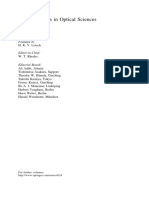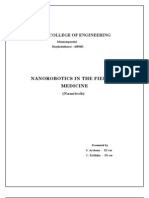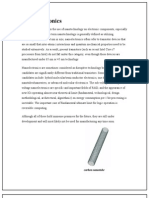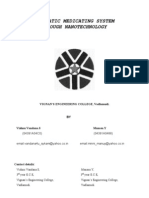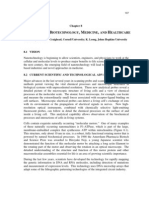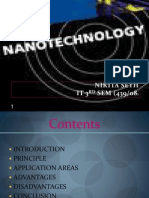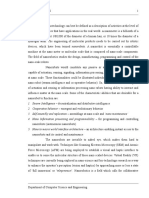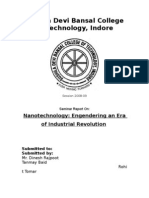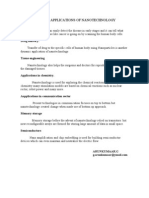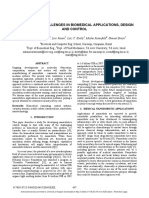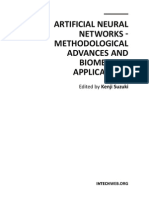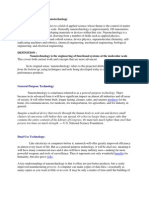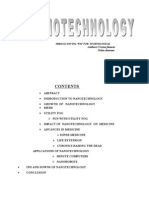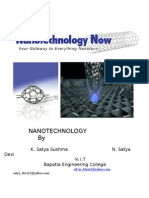Sensor Based Autonomous Medical Nanorobots A Cure To Demyelination
Sensor Based Autonomous Medical Nanorobots A Cure To Demyelination
Uploaded by
Arul PrakashCopyright:
Available Formats
Sensor Based Autonomous Medical Nanorobots A Cure To Demyelination
Sensor Based Autonomous Medical Nanorobots A Cure To Demyelination
Uploaded by
Arul PrakashOriginal Description:
Original Title
Copyright
Available Formats
Share this document
Did you find this document useful?
Is this content inappropriate?
Copyright:
Available Formats
Sensor Based Autonomous Medical Nanorobots A Cure To Demyelination
Sensor Based Autonomous Medical Nanorobots A Cure To Demyelination
Uploaded by
Arul PrakashCopyright:
Available Formats
1
Abstract Nowadays medical science is more and more
improving with the blessings of new scientific discoveries.
Nanotechnology is such a field which is changing vision of
medical science. New automated procedures are being discovered
with new aspects of self guided nanorobots. Nanorobot is an
excellent tool for future medicine. We can envision a day when
you could inject billions of these nanorobots that would float
around in your body. Nanorobots could carry and deliver drugs
into defected cells. These nanorobots will be able to repair tissues,
clean blood vessels and airways, transform our physiological
capabilities, and even potentially counteract the aging process [1].
Many scientist working on this bright field of nanorobotics
specially on Alzheimer disease and cancer treatments [2]. The
researchers are also working on nanomanipulation,
nanopositioning and also on the nano-level control systems [3]. In
this paper we are going to address a disease called dymyelination
and propose a nanorobotic control system for the cure.
Demyelination is a disease of the nervous system where the
protecting layer of neurons called myelin sheath is damaged. This
disease hampers the conduction of signals in the affected nerves,
causing impairment in sensation, movement, cognition, or other
functions depending on which nerves are involved. This paper
describes an innovative approach for the development of
nanorobots that use neural network for identifying and repairing
the damaged, demyelinated neurons. Firstly, the disease it self
will be addressed to understand the later work easily, then a
control system for automated nanorobots to cure dymyelination
will be described. In later portion the proposed control system
will be simulated to show the stability and usefulness of proposed
design. The nanorobots operate in a virtual environment with
nerve signals carrying nerve impulses. This paper also presents
the control and the simulation of nerve-borne nanorobots to
find and repair the affected nerves.
Index Terms demyelination, control system, nanorobots,
neural nanotechnology.
I. INTRODUCTION
ANOROBOTS are expected to enable significant new
methodologies in diagnosis, medical therapies, and
minimally invasive surgery [4-8]. The nanorobots
hardware feasibility may be observed as the result of most
recent advances in a broad range of manufacturing techniques
[9]. A first series of nanotechnology prototypes for molecular
machines are being investigated in different ways [6, 10-15],
and some interesting device propulsion and sensing approaches
have been presented [16-19]. Some work has been done in
2D on cellular automata with the examination of collective
behaviors of large numbers of robots to locate specific types of
tissue [20]. More complex molecular machines, or nanorobots,
having embedded nanoscopic features may provide broad
advances on health care sector [21-26].
Most researches on Nanorobots have been done for different
type of automated and accurate medical target identification. [4]
For example- Chemical signals can be used for identifying
medical target in cerebral treatment. The amyloid- protein
deposits show changes on gradients as a symptom of
Alzheimer disease [28, 29]. This information serves for the
early diagnosis of Alzheimer disease and to guide possible
immunotherapy treatments, with more efficient
neurotransmitters delivery, like dopamine and amino acids
such as g-aminobutyrate (GABA), with better medical
administration. Nanorobots can use such signals to delivery
genomic improved myelin basic protein [30].
Considering the ability of the nanorobots to be able to
navigate over the myelin sheath of a nerve, they can help in
better diagnosis and improved treatment procedures for
diseases in relation to nerve signal disorders. A very
promising application of nerve-borne nanorbots is the efficient
delivery of genomic improved myelin basic protein. Here a
nanorobot can be made to detect leakage of charge and
thereby detecting demyelinated portion of a nerve. And then
Synthetic myelin, carried by nanorobots, can then be
effectively delivered to these affected portions. In our work we
point out this possible application of using nanorobots on
nerves and demonstrate a control system based on classical
approach where nanorobots repair a damaged
(demyielinated) nerve.
II. BACKGROUND OF MEDICAL NANOROBOTICS
Recent developments in nano-electronics and nano-
biotechnology is providing feasible development pathways to
enable molecular machine manufacturing, including embedded
and integrated devices which can comprise the main sensing,
actuation, data transmission, remote control uploading, and
coupling power supply subsystems addressing the basics for
operation of medical nanorobots [4].
The application of new materials has demonstrated a
large range of possibilities for use in manufacturing better
sensors and actuators with nano-scale sizes [4].
Manufacturing silicon-based chemical and motion sensor
arrays using a two-level system architecture hierarchy has been
successfully conducted in the last 15 years [32]. Tunneling
current sensor for a long-range nano-positioning device has
been developed and demonstrated few days back [33]. A
recent actuator with biologically-based components has been
proposed [35]. Such actuators can be utilized in nano-scale
Sensor based Autonomous Medical Nanorobots
A cure to Demyelination
S. M. Masudur Rahman Al-Arif, Niamul Quader, Al Mamun Shaon, Dr. Kazi Khairul Islam
Department of Electrical and Electronic Engineering
Islamic University of Technology (IUT)
BoardBazar, Gazipur-1704, Bangladesh.
N
Cyber Journals: Multidisciplinary Journals in Science and Technology, Journal of Selected Areas in Nanotechnology (JSAN), September Edition, 2011
mechanical devices to pump fluids, open and close valves, or
to provide translational movement. Different other kinds of
nano-sized actuators, such as electromagnetic,
electrostatic, electro-thermal are also being researched and
demonstrated now-a-days [34].
Nanotechnology is moving fast towards nano
fabrication. Chemically assembled electronic nanotechnology
provides an alternative to using a Complemen
Oxide Semiconductor (CMOS) for constructing circuits with
feature sizes in the tens of nanometers [36]. The feasibility of
advancing techniques for control [31] and
molecular machines should be understood as emergent
results from actual and upcoming stages of
nanotechnology based on nano-electronics
and genomics research. New possibilities are coming from
these developments which will enable new medical procedures.
As a result of these researches CNTs (carbon nano
DNA (Deoxyribo-Nucleic acid) are now being considered as
recent candidates for new forms of nano-electronics [
lastly recent developments in bio-molecular computing have
demonstrated the feasibility of bio-computers [27
promising and much needed first step toward future
processors.
III. NERVE IMPULSE & DEMYELINATION
A. Neuron
The nervous system is an organ system
network of specialized cells called neurons that coordinate the
actions of an animal and transmit signals between different
parts of its body. The protecting layer of neurons is called
Myelin. It is a dielectric (electrically insulating
forms a layer, the myelin sheath, usually around only the
of a neuron. It is essential layer for the proper functioning of
the nervous system.
Figure 1: Structure of Neuron
B. Nerve Impulse Propagation
Neurons send signals to other cells as electrochemical
waves travelling along thin fibers called axons
chemicals called neurotransmitters to be released at junctions
called synapses. A cell that receives a synaptic signal may be
excited, inhibited, or otherwise modulated.
Neurones and muscle cells are electrically excitable cells,
which mean that they can transmit electrical nerve impulses.
These impulses are due to events in the cell membrane.
2
mechanical devices to pump fluids, open and close valves, or
ifferent other kinds of
electromagnetic, piezoelectric,
thermal are also being researched and
Nanotechnology is moving fast towards nano-electronics
fabrication. Chemically assembled electronic nanotechnology
omplementary Metal
emiconductor (CMOS) for constructing circuits with
The feasibility of
] and manufacturing
molecular machines should be understood as emergent
results from actual and upcoming stages of
electronics, new materials
possibilities are coming from
enable new medical procedures.
CNTs (carbon nano-tubes) and
Nucleic acid) are now being considered as
electronics [37]. And
molecular computing have
computers [27], a very
needed first step toward future nano-
EMYELINATION
organ system containing a
that coordinate the
and transmit signals between different
parts of its body. The protecting layer of neurons is called
electrically insulating) material that
lly around only the axon
. It is essential layer for the proper functioning of
Figure 1: Structure of Neuron
Neurons send signals to other cells as electrochemical
axons, which cause
to be released at junctions
. A cell that receives a synaptic signal may be
Neurones and muscle cells are electrically excitable cells,
which mean that they can transmit electrical nerve impulses.
These impulses are due to events in the cell membrane. The
resting potential tells us about what happens when a neuron is
at rest. An action potential occurs when a neuron sends
information down an axon. This involves an explosion of
electrical activity, where the nerve and muscle cells resting
membrane potential changes. In nerve and muscle cells the
membranes are electrically excitable, this means they can
change their membrane potential, and this is the basis of the
nerve impulse. The neurotransmitters
potassium channels in these cells are voltage
means that they can open and close depending on the voltage
across the membrane. The normal membr
the axon of nerve cells is 70mV, and since this potential can
change in nerve cells it is called the resting potential. When a
stimulus is applied a brief reversal of the membrane potential,
lasting about a millisecond, occurs. This b
called the action potential.
Once an action potential has started it is moved
(propagated) along an axon automatically. The local reversal
of the membrane potential is detected by the surrounding
voltage-gated ion channels, which open whe
changes enough.
Figure 2: Nerve Impulse Propagation
C. Demyelination
Demyelination is the loss of the myelin sheath insulating
the nerves, and is the hallmark of some
autoimmune diseases, including
disseminated encephalomyelitis, transverse myelitis
demyelinating polyneuropathy, Guillain
central pontine myelinosis etc. W
conduction of signals along the nerve can be impaired or lost
and the nerve eventually withers.
Figure 3: Loss of signal in Demyelinated Neuron
resting potential tells us about what happens when a neuron is
An action potential occurs when a neuron sends
This involves an explosion of
where the nerve and muscle cells resting
membrane potential changes. In nerve and muscle cells the
membranes are electrically excitable, this means they can
change their membrane potential, and this is the basis of the
neurotransmitters i.e. sodium and
potassium channels in these cells are voltage-gated, which
means that they can open and close depending on the voltage
across the membrane. The normal membrane potential inside
70mV, and since this potential can
change in nerve cells it is called the resting potential. When a
stimulus is applied a brief reversal of the membrane potential,
lasting about a millisecond, occurs. This brief reversal is
Once an action potential has started it is moved
(propagated) along an axon automatically. The local reversal
of the membrane potential is detected by the surrounding
gated ion channels, which open when the potential
Figure 2: Nerve Impulse Propagation
is the loss of the myelin sheath insulating
the nerves, and is the hallmark of some neurodegenerative
diseases, including multiple sclerosis, acute
transverse myelitis, chronic
Guillain-Barr Syndrome,
etc. When myelin degrades,
conduction of signals along the nerve can be impaired or lost
Figure 3: Loss of signal in Demyelinated Neuron
Demyelination can results in thousand complexities
starting from loss of balance, optical illusions to short term
memory loss and loss of concentration, judgment
Each year thousands of people around the world
this disease. And most of the people have to live with it
because the expensive conventional surgery method is very
complex, almost inaccessible and do not cure perfectly.
IV. PROPOSED NANOROBOTS
Nanorobot being placed on nerves, it can detect electrical
signals i.e nerve impulses and takes decision on which path it
will take. We address this procedure by illustrating a
nanorobot whose sole aim is to find demyelinated area and to
deliver synthetic myelin sheath on it. A team of this nanorobot
can deliver us an autonomous, accurate and minimum invasive
surgical procedure to cure demyelination.
Figure 4: Hypothetical model of Proposed Nanorobot
A. Actuator
There are different kinds of actuators, such as
electromagnetic, piezoelectric, electrostatic, electrothermal,
where they should be utilized depending on the aim and the
workspaces where they will be applied. A agella motor has
been quoted quite frequently as an example for a kind of
biologically inspired actuator for molecular machine
propulsion. Adenosine triphosphate, also known in short as
ATP, is equally used as an alternative for nanomotors [
DNA and RNA (ribonucleic acid) prototypes were also
proposed for designing different types of devices. A set of
fullerene structures were presented for nanoactuators. The use
of CNTs as conductive structures permits electrostatically
driven motions providing the forces necessary for nano
manipulation [4]. For ours purpose, the use of CMOS as an
actuator based on biological patterns and CNTs is cons
natural choice.
B. Directional Control
While nerve impulses in unmyelinated neurons have a
maximum speed of around 1 m/s, in myelinated neurons they
travel at 100 m/s. electrical voltage is to be detected and
passed over low pass filter to get the sensor voltages V
3
can results in thousand complexities
starting from loss of balance, optical illusions to short term
judgment or reasoning.
of people around the world suffer from
le have to live with it
because the expensive conventional surgery method is very
complex, almost inaccessible and do not cure perfectly.
ANOROBOTS
Nanorobot being placed on nerves, it can detect electrical
ecision on which path it
will take. We address this procedure by illustrating a
nanorobot whose sole aim is to find demyelinated area and to
on it. A team of this nanorobot
can deliver us an autonomous, accurate and minimum invasive
Figure 4: Hypothetical model of Proposed Nanorobot
There are different kinds of actuators, such as
tic, electrothermal,
where they should be utilized depending on the aim and the
agella motor has
been quoted quite frequently as an example for a kind of
biologically inspired actuator for molecular machine
ion. Adenosine triphosphate, also known in short as
ATP, is equally used as an alternative for nanomotors [7].
DNA and RNA (ribonucleic acid) prototypes were also
proposed for designing different types of devices. A set of
ed for nanoactuators. The use
of CNTs as conductive structures permits electrostatically
driven motions providing the forces necessary for nano-
]. For ours purpose, the use of CMOS as an
actuator based on biological patterns and CNTs is considered a
While nerve impulses in unmyelinated neurons have a
m/s, in myelinated neurons they
m/s. electrical voltage is to be detected and
sensor voltages V
xi
.
text
Vx1
Vx2
-
Figure 5: Sensor positions and angel of rotation
The outputs of four sensors are fed into a summing circuit
with consideration to their weights. The resulting
input for an actuator which is connected to the front wheels.
Actuator
T(s)
+
+
Td(s)
Vsensor
Figure 6: Block diagram of Directional Co
Vehicle dynamics is considered to be of the form
1
C. Speed Control:
The back wheels are for speed control. Stability in speed
and rejection of disturbances like Brownian motion is crucial
for positive performance of the nan
controller is used and stability and performance of the system
is studied by using hypothetical actuator model.
Compensator
Gc(s)
Amplifier
K
Actuator
G
Speed
Sensor
H(s)
R(s)
Figure 7: Block Diagram of Speed Control System
Now here Es Rs Ys ; for unity feedback
Es
Rs
Td
Where L(s) = k G
c
(s) Ga(s).
T
d
(s) is dominant in low frequency. We want Sensitivity
function [1/{1+L(s)}] to be small for T
and Complementary Sensitivity function [L(s)/{1+L(s)}] to be
low at high frequency.
Vx3
Vx4
Figure 5: Sensor positions and angel of rotation
The outputs of four sensors are fed into a summing circuit
with consideration to their weights. The resulting Veffective is
input for an actuator which is connected to the front wheels.
Vehicle
Dynamics
)
(s)
Figure 6: Block diagram of Directional Control
Vehicle dynamics is considered to be of the form
The back wheels are for speed control. Stability in speed
and rejection of disturbances like Brownian motion is crucial
for positive performance of the nanorobots. A lead lag
controller is used and stability and performance of the system
is studied by using hypothetical actuator model.
Actuator
Ga(s)
Vehicle
Dynamics
Gd(s)
Td(s)
Na(s)
V(s)
Figure 7: Block Diagram of Speed Control System
; for unity feedback
Tds
Nas;
(s) is dominant in low frequency. We want Sensitivity
function [1/{1+L(s)}] to be small for T
d
(s) at low frequency,
and Complementary Sensitivity function [L(s)/{1+L(s)}] to be
So we want loop gain L(s) to be large at low frequency and
small at high frequency. To meet this lead lag controller is
used.
Figure 8: Lead Lag controller with a=10, b=1
D. Weight Control
A very significant design requirement is that the
nanorobots always stay nerve-borne. To do this we simply
propose to use the concept of attractive force between two
current carrying conductors- one being the nerve and the other
being current carrying nanowire on the nanorobot
Figure 9: Simple illustration of forces between nano
E. Energy Supply
The most effective way to keep the nanorobot operating
successfully is to establish the use of a continuous available
source of power. The energy must be available and delivered
to the nanorobot while it is performing prede
operational environment. For a medical nanorobot, this means
that the device has to keep working inside the human body,
sometimes for long periods, and requires easy access to clean
and controllable energy to maintain efficient operation.
Some possibilities to power the nanorobot
from ambient energy. Temperature displacements could
likewise generate useful voltage differentials. Electromagnetic
radiation from light is another option for energy generation in
determined open environments [39] but not for in vivo
medical nanorobotics. Most recently, remote inductive
powering has been used both for RFID (radio frequency
4
So we want loop gain L(s) to be large at low frequency and
lead lag controller is
Figure 8: Lead Lag controller with a=10, b=1
A very significant design requirement is that the
borne. To do this we simply
propose to use the concept of attractive force between two
one being the nerve and the other
wire on the nanorobot.
Figure 9: Simple illustration of forces between nano-wires
The most effective way to keep the nanorobot operating
successfully is to establish the use of a continuous available
The energy must be available and delivered
to the nanorobot while it is performing predened tasks in the
operational environment. For a medical nanorobot, this means
that the device has to keep working inside the human body,
d requires easy access to clean
and controllable energy to maintain efficient operation.
Some possibilities to power the nanorobot can be provided
from ambient energy. Temperature displacements could
likewise generate useful voltage differentials. Electromagnetic
radiation from light is another option for energy generation in
] but not for in vivo
cal nanorobotics. Most recently, remote inductive
powering has been used both for RFID (radio frequency
identification device) and biomedical implanted devices to
supply power on the order of milliwatts. A low frequency
energy source can be sufficient to o
functional approach presents the possibility of supplying
energy in a wireless manner [4]. Thus, it enables one to
operate sensors and actuators necessary for the controlled
operation of nanorobots inside the human body.
V. SIMULATIONS AND
A. Simulation for Directional Control
Transfer function of directional control can be found from
the block diagram of Figure 7.
Assuming T
d
(s) = 0 (i.e. no disturbances) it can be written as
1
2.26 10
9.04
10
1
Values used in the equations are hypothetical and calculated
based on practical speculations by taking mass and volume in
nano-scale. The actuator transfer function is taken similar to a
macro-level actuator but in nano-range.
Figure 10: Step response of Directional Control
Step response of the open loop directional control indicates
that even a small V
effective
can rotate the direction of
movement. This sensitive control ensures that nanorobot
moves toward the damaged area only.
B. Simulation for Speed Control
The speed control transfer function for speed control can be
written as-
,
As stated before we will use a lead lag controller as a
compensator with a pole at b and zero at
will be same as direction control actuator and vehicle
dynamics as used before. So above mentioned equation can be
identification device) and biomedical implanted devices to
supply power on the order of milliwatts. A low frequency
energy source can be sufficient to operate nanorobots. This
functional approach presents the possibility of supplying
]. Thus, it enables one to
operate sensors and actuators necessary for the controlled
operation of nanorobots inside the human body.
S AND RESULTS
Simulation for Directional Control
function of directional control can be found from
,
(i.e. no disturbances) it can be written as-
1
04 10
10
10
2 7
Values used in the equations are hypothetical and calculated
based on practical speculations by taking mass and volume in
nsfer function is taken similar to a
range.
Figure 10: Step response of Directional Control
Step response of the open loop directional control indicates
can rotate the direction of
movement. This sensitive control ensures that nanorobot
moves toward the damaged area only.
The speed control transfer function for speed control can be
As stated before we will use a lead lag controller as a
b and zero at a; actuator model
will be same as direction control actuator and vehicle
sed before. So above mentioned equation can be
5
re-written as-
10
1 2 7
2.26 10
9.04 10
Now to find out appropriate range of values of a, b and
k we have applied classical approach of stability analysis,
Routh Criterion.
Table 1: Routh Table
235.04 524.32 610.2p=C 126.5p+k
610.2+235.04p=B 126.5 524.32p D kz
E
126.5
From the table it is eminent that to have a stable system-
126.5
> 0
>
126.5
So we have found valid range of a, b and k which can
also be demonstrated in 3D plot.
Figure 11: Three dimensional plot of stability region
The stability region exists above the stability surface. So we
can choose a=10 and b=1. So Compensator transfer function
Root locus and step response of the compensated system
now can be plotted to show the stability.
Figure 12: Root Locus Plot of Proposed System
Figure 13: Step response of proposed System
So the compensated system is stable. Nanorobot with this
control system can successfully move on the nerve to find
demyelinated neurons. State space representation of this
system have been found using MATLAB and rank of system
was 6, same as the order of the system which means the
system is both controllable and observable.
VI. FURTHER DEVELOPMENTS
Although the direction, speed and energy supply system
was discussed but we are still working on the payload delivery
system, where it is necessary to sense where exactly the
delivery of myelin sheath should be made.
Here in this paper we have presented a theoretical
development of a stable nanorobotic system that can be used
to cure demyelinated neurons, but practically manufacturing
of such nanorobots is not yet possible due to several practical
6
limitations in the process. However technologies are
developing so fast and time will come when producing
nanorobots like this one will not be difficult. With the
appropriate technologies in hand we can even think of
improving the system for further complex operations.
The perspective that the same manufacturing technologies
required to assemble this nanorobot could also be applied to a
broad range of fields. The research and development of
nanorobots can also provide new technologies and devices for
enhanced industrial automation. As a result of such
development, more effective and safe operations are expected
for manufacturing processes, as well as better electronics,
featuring higher performance and lower requirements.
The application of nanorobots with embedded sensor
devices for drug and diagnosos is an interesting subjcet, which
can enable significant improvements as a big precission device
for medical treatments [5]. Thus all the possibilities needs to
be considered to have better utilisation nanorobots in future
medical applications.
VII. CONCLUSION
This paper has proposed a new concept of using nerve-
borne sensor based nanorobots for medical applications.
Nerve-borne nanorobots should help, through sensing nerve
impulse singnals, to provide better understanding of
correlation of nerve signals and disease. They should also be
able to help give early diagnosis and provide new therapeutic
procedures. Again even they can help us to invastigate the
nervous system from close point of vies. Here classical control
systems analysis was adopted to illustrate one specific
application: to find the demyelinated neuron automatically and
to deliver synthetic myelin sheath to demyelinated portion of
nerve.
Stability of the nanorobots and disturbance rejection, like
brownian motion and electrical noise, are crucial to the
performance of the nanorobots. They define the limitations of
the nanorobots, and thus limit the applications where they can
be used. Therefore, collecting data and adapting to the new
situation with better control methods is paramount to the
future success of the use of nanorobots in medicine.
Although this nanorobot is not a reality today but with the
advancement of technology this proposed nanorobot can cure
thousands of demyelination disease victims with very low cost
and accurate minimal invasive surgery.
ACKNOWLEDGMENT
All praises are for ALMIGHTY ALLAH, without whose
help anything would be impossible.
The authors would like to thank Professor Dr. Kazi Khairul
Islam his help at different stages of this publication.
REFERENCES
[1] Hariharan, R. and Manohar, J. 2010 "Nanorobotics as medicament:
(Perfect solution for cancer)" INTERACT 2010, page 4-7.
[2] Venkatesan, M. ; Jolad, B. 2010 Nanorobots in cancer treatment
INTERACT 2010, page 258-264
[3] Ladjal, H. ; Hanus, J.-L. ; Ferreira, A. 2009 H robustification control
of existing piezoelectric-stack actuated nanomanipulators IEEE IRCA
2009, page 3353-3358
[4] Adriano cavalcanti, Bijan Shirinzadeh, Robert A Freitas Jr and Tad
Hogg 2008 "Nanorobot architecture for medical target identification"
IOP Publishing.
[5] Freitas R A Jr 1999 "Nanomedicine vol I Basic Capabilities" Landes
Bioscience http://www.nanomedicine.com.
[6] Cavalcanti A 2003 "Assembly automation with evolutionary nanorobots
and sensor-based control applied to nanomedicine" IEEE Trans.
Nanotechnoly. 28-27.
[7] Freitas R A Jr 2005" Nanotechnology, nanomedicine and nanosurgery"
Int. J. Surg. 3 1-4.
[8] Montemagno C D and Bachand G D 1999 "Constructingnanomechanical
devices powered by biomolecular motors" Nanotechnology 10 225-231.
[9] Cavalcanti A, Shirinzadeh B, Freitas R A Jr and Kretly L C 2007
"Medical nanorobot architecture based on nanobioelectronics" Recent
Patents on Nanotechnologyvol 1 (Pennington, NJ, USA: Bentham
Science Publishers Ltd.) pp 1-10.C. J. Kaufman, Rocky Mountain
Research Lab., Boulder, CO, private communication, May 1995.
[10] Montemagno C D and Bachand G D 1999 Constructing nanomechanical
devices powered by biomolecular motors Nanotechnology 10 22531.
[11] Cavalcanti A, Shirinzadeh B, Freitas R A Jr and Kretly L C 2007
Medical nanorobot architecture based on nanobioelectronics Recent
Patents on Nanotechnology vol 1 (Pennington, NJ, USA: Bentham
Science Publishers Ltd.) pp 110.
[12] Mathieu J B, Beaudoin G and Martel S 2006 Method of propulsion of a
ferromagnetic core in the cardiovascular system through magnetic
gradients generated by an MRI system IEEE Trans. Biomed. Eng. 53
292299.
[13] Sierra D P, Weir N A and Jones J F 2005 A review of research in the
eld of nanorobotics Sandia Report Ofce of Scientic and Technical
Information, US Department of Energy.
[14] Behkam B and Sitti M 2006 Design methodology for biomimetic
propulsion of miniature swimming robots Trans. ASME J. Dyn. Syst.
Meas. Control 128 3643.
[15] Jiang H-W, Wang S-G, Xu W, Zhang Z-Z and He L 2005 Research and
progress in bio-nano-robot Jiqiren (Robot) 27 569574.
[16] Xi J, Schmidt J J and Montemagno C D 2005 Self-assembled
microdevices driven by muscle Nat. Mater. 4 180184.
[17] Villar I D, Matias I R, Arregui F J and Claus R O 2005 ESA-based in-
ber nanocavity for hydrogen-peroxide detection IEEE Trans.
Nanotechnol. 4 187193.
[18] LiW J, Xi N, FungW K and Wong T S 2004 Nanorobotics and
nanomanipulation Encyclopedia of Nanoscience and Nanotechnology
vol 7 (Valencia, CA, USA: American Scientic Publishers) pp 351365.
[19] Ummat A, Sharma G, Mavroidis C and Dubey A 2005 Bio-
nanorobotics: state of the art and future challenges Biomedical
Engineering Handbook (London, UK: CRC Press).
[20] Lewis M A and Bekey G A 1992 The behavioral self-organization of
nanorobots using local rules Proc. IEEE Int. Conf. on Intelligent Robots
and Systems (Raleigh, NC, July 1992).
[21] Couvreur P and Vauthier C 2006 Nanotechnology: intelligent design to
treat complex disease Pharm. Res. 23 14171450.
[22] Katz E, Riklin A, Shabtai V H, Willner I and B uckmann A F 1999
Glucose oxidase electrodes via reconstitution of the apo-enzyme:
tailoring of novel glucose biosensors Anal. Chim. Acta 385 4558.
[23] McDevitt M R et al 2001 Tumor therapy with targeted atomic
nanogenerators Science 294 15371540.
[24] Patel G M, Patel G C, Patel R B, Patel J K and Patel M 2006 Nanorobot:
a versatile tool in nanomedicine J. Drug Targeting 14 6367.
[25] Toth-Fejel T T 2000 Agents, assemblers, and ANTS: scheduling
assembly with market and biological software mechanisms
Nanotechnology 11 133137.
[26] Vaughn J R 2006 Over the horizon: potential impact of emerging trends
in information and communication technology on disability policy and
practice National Council on Disability (Washington DC, Dec.).
[27] Sand S B B and Wiest O 2003 Theoretical studies of mixed-valence
transition metal complexes for molecular computing page 285291.
7
[28] Bacskai B J, Kajdasz S T, Christie R H, Carter C, Games D, Seubert P,
Schenk D and Hyman B T 2001 Imaging of amyloid-beta deposits in
brains of living mice permits direct observation of clearance of plaques
with immunotherapy Nat. Med. 7 36972.
[29] Sola E, Prestori F, Rossi P, Taglietti V and DAngelo E 2004 Increased
neurotransmitter release during long-term potentiation at mossy bre-
granule cell synapses in rat cerebellum J. Physiol. 557 84361.
[30] Campagnoni A T and Macklin W B 1988 Cellular and molecular aspects
of myelin protein gene expression Mol. Neurobiol. Spring 2 4189.
[31] Cavalcanti A and Freitas R A Jr 2005 Nanorobotics control design: a
collective behavior approach for medicine IEEE Trans. Nanobiosci. 4
133140.
[32] Albert K J, Lewis N S, Schauer C L, Sotzing G A, Stitzel S E, Vaid T P
and Walt D R 2000 Cross-reactive chemical sensor arrays Chem. Rev.
100 25952626.
[33] Weckenmann Albert, Hoffmann Jrg, Schuler Alexander, Development
Of A Tunnelling Current Sensor For A Long-Range Nano-Positioning
Device.
[34] Suh J W, Darling R B, Bohringer K F, Donald B R, Baltes H and
Kovacs G T A 1999 CMOS integrated ciliary actuator array as a
general-purposemicromanipulation too for small objects J.
Microelectromech. Syst. 8 483496.
[35] Xiong P, Molnar S V, Moerland T S, Hong S and Chase P B 2006
Biomolecular-based actuator US Patent Specication 7014823.
[36] Rosewater D L and Goldstein S C 2006 Methods of chemically
assembled electronic nanotechnology circuit fabrication US Patent
Specication 7064000.
[37] Dubin V M 2006 Nanofabrication using carbon nanotubes and DNA US
Patent Specication 7122461.
[38] Yarmolich Dmitry Simulation of Nerve Impulse Propagation
323674218.
[39] Liu W, Wyk J D V and OdendaalW G 2004 Design and evaluation of
integrated electromagnetic power passives with vertical surface
interconnections IEEE Applied Power Electronics Conf. and Exposition
(Blacksburg VA,Feb. 2004) vol 2, pp 958963.
You might also like
- 10 Unsolved MysteriesDocument7 pages10 Unsolved Mysteriesbogdan marianNo ratings yet
- Plasmonics:From Basics To Advanced TopicsDocument330 pagesPlasmonics:From Basics To Advanced TopicsOzan ErturkNo ratings yet
- Bala ThesiesDocument15 pagesBala ThesiesDDanger ZoneNo ratings yet
- Nano RoboticsDocument13 pagesNano RoboticsKrithika ChandrasekaranNo ratings yet
- BY Y.Satyavani, Contact: 9885937442: Vaagdevi College of Engneering WarangalDocument12 pagesBY Y.Satyavani, Contact: 9885937442: Vaagdevi College of Engneering WarangalManeesh BabuNo ratings yet
- Nanoelectronics: Nanoelectronics Refer To The Use of Nanotechnology On Electronic Components, EspeciallyDocument9 pagesNanoelectronics: Nanoelectronics Refer To The Use of Nanotechnology On Electronic Components, EspeciallyBen Mathew ThomasNo ratings yet
- Neuromorphic ControlDocument74 pagesNeuromorphic ControlsudiptomondalNo ratings yet
- Automatic Medicatng System Through Nanotechnology Vignan GunturDocument17 pagesAutomatic Medicatng System Through Nanotechnology Vignan GunturManju CharithaNo ratings yet
- 7376222ct101-Tte-01 02 2023Document2 pages7376222ct101-Tte-01 02 2023MeAadarshNo ratings yet
- Chapter 08Document14 pagesChapter 08Pankaj KumarNo ratings yet
- NeuronDocument31 pagesNeuronPeter HantzNo ratings yet
- CardiologyDocument10 pagesCardiologyGergő BárdosNo ratings yet
- Ajptr 92002 - 7074Document10 pagesAjptr 92002 - 7074Nikhil VoonaNo ratings yet
- The Smartest Materials: The Future of Nanoelectronics in MedicineDocument5 pagesThe Smartest Materials: The Future of Nanoelectronics in MedicineAgnibha DasguptaNo ratings yet
- Multi-Channel Neural Recording Implants A Review PDFDocument29 pagesMulti-Channel Neural Recording Implants A Review PDFSudheer RajaNo ratings yet
- Indira Gandhi Engg. College Sagar Indira Gandhi Engg. College SagarDocument26 pagesIndira Gandhi Engg. College Sagar Indira Gandhi Engg. College SagarTechieNo ratings yet
- J Leukocyte Bio - 2005 - McNeil - Nanotechnology For The BiologistDocument10 pagesJ Leukocyte Bio - 2005 - McNeil - Nanotechnology For The Biologistankitb.cse2021No ratings yet
- J Leukocyte Bio - 2005 - McNeil - Nanotechnology For The BiologistDocument10 pagesJ Leukocyte Bio - 2005 - McNeil - Nanotechnology For The BiologistLLANCHIPA RAMIREZ DIEGONo ratings yet
- Approach To Nano ElectronicsDocument7 pagesApproach To Nano ElectronicsDheera SaxenaNo ratings yet
- First Self Powered NanoDocument3 pagesFirst Self Powered NanoprasanthyemineniNo ratings yet
- Nanosciences Evolution or RevolutionDocument9 pagesNanosciences Evolution or RevolutionClaramaria RodriguezNo ratings yet
- Paper Presentation On Embedded Systems: Done By, C. Aravind, S. Nageswaran, Maharaja Engg. College, AvinashiDocument15 pagesPaper Presentation On Embedded Systems: Done By, C. Aravind, S. Nageswaran, Maharaja Engg. College, AvinashiAravindebooksNo ratings yet
- Chap 1&2 NanobiotechDocument5 pagesChap 1&2 Nanobiotechbalaajkhan2205No ratings yet
- Nikita Seth IT3 SEM (439/08Document14 pagesNikita Seth IT3 SEM (439/08Nikita SethNo ratings yet
- CN NanoDocument9 pagesCN NanoDương TrươngNo ratings yet
- Nano Computer Design Based On Intra Body Nanoscale Neuro-Spike Communication A Nanonetwork ParadigmDocument4 pagesNano Computer Design Based On Intra Body Nanoscale Neuro-Spike Communication A Nanonetwork Paradigmsondv89No ratings yet
- Sensors 20 00904 v2Document2 pagesSensors 20 00904 v2Generation GenerationNo ratings yet
- Neural EngineeringDocument11 pagesNeural Engineeringbrian3442No ratings yet
- Nano Technology 2Document14 pagesNano Technology 2Sunil PillaiNo ratings yet
- A: N, N, N: Pplications Anodevices Anoelectronics AND AnosensorsDocument20 pagesA: N, N, N: Pplications Anodevices Anoelectronics AND AnosensorsNeha VermaNo ratings yet
- NanoDocument44 pagesNanolinusbusiness solutionsNo ratings yet
- Nanomotors in The Field of Medicine - Essay - AchyuthDocument5 pagesNanomotors in The Field of Medicine - Essay - Achyuthdoxoyi6563No ratings yet
- Nanobots in MedicineDocument9 pagesNanobots in Medicine060 ADRIEL BraganzaNo ratings yet
- Nano Neurociencia PDFDocument10 pagesNano Neurociencia PDFjhrealpeNo ratings yet
- NanoRobotics DOCUMENTDocument16 pagesNanoRobotics DOCUMENTAnirudh D DyagaNo ratings yet
- Nano TechnologyDocument4 pagesNano TechnologyTeja MothukuriNo ratings yet
- Internet of Nano, Bio-Nano, Biodegradable And-4-5Document2 pagesInternet of Nano, Bio-Nano, Biodegradable And-4-57d96d1b6a8No ratings yet
- The Nano WorldDocument3 pagesThe Nano Worldandreafuentevilla4No ratings yet
- Nanotechnology (Seminar)Document17 pagesNanotechnology (Seminar)TB100% (5)
- Nanomedicine - An OverviewDocument9 pagesNanomedicine - An OverviewSudeep BhattacharyyaNo ratings yet
- Jurnal Nano TechnologyDocument5 pagesJurnal Nano TechnologyNaseh Ya NasehNo ratings yet
- Applications of NanotechnologyDocument1 pageApplications of NanotechnologyArun KumaarNo ratings yet
- Nanoscience and Anano TechnologyDocument19 pagesNanoscience and Anano TechnologyARAVINDACHUNo ratings yet
- Nano MaterialsDocument4 pagesNano MaterialsThiagu ManiNo ratings yet
- Nano PresentationDocument89 pagesNano PresentationVivek Vous AimeNo ratings yet
- Nanorobotic Challenges in Biomedical Applications Design and ControlDocument4 pagesNanorobotic Challenges in Biomedical Applications Design and ControlGergő BárdosNo ratings yet
- Nano SurveyDocument20 pagesNano SurveyAsil AsilaNo ratings yet
- Asish WordDocument18 pagesAsish WordAsish Kr DasNo ratings yet
- NanotechnologyDocument20 pagesNanotechnologycesureportNo ratings yet
- Artificial Neural Networks Methodological Advances and Bio Medical Applications by Kenji SuzukiDocument374 pagesArtificial Neural Networks Methodological Advances and Bio Medical Applications by Kenji Suzukizubairaw24100% (1)
- NanotechnologyDocument7 pagesNanotechnologyV_SriguruNo ratings yet
- Nanotechnology By: AbstractDocument13 pagesNanotechnology By: Abstractapi-197993690% (1)
- Artificial Neural Networks - Methodological Advances and Bio Medical ApplicationsDocument374 pagesArtificial Neural Networks - Methodological Advances and Bio Medical ApplicationsMustafa Dgn100% (1)
- Nanotechnology (1) - 1Document13 pagesNanotechnology (1) - 1Raju BanneNo ratings yet
- Miracls Paving Way For TechnologicalDocument14 pagesMiracls Paving Way For TechnologicalchiyaseshuNo ratings yet
- Nanotechnology By: K. Satya Sushma N. Satya Devi I.T Bapatla Engineering CollegeDocument12 pagesNanotechnology By: K. Satya Sushma N. Satya Devi I.T Bapatla Engineering CollegeUday TejaNo ratings yet
- Seminar On NANOTECHNOLOGYDocument11 pagesSeminar On NANOTECHNOLOGYanupkumar9916No ratings yet
- Nanotechnology: The Limitless Possibilities of Tiny ScienceFrom EverandNanotechnology: The Limitless Possibilities of Tiny ScienceNo ratings yet
- World of Nanobioengineering: Potential Big Ideas for the FutureFrom EverandWorld of Nanobioengineering: Potential Big Ideas for the FutureNo ratings yet
- Design Development and Analysis of a Nerve Conduction Study System An Auto Controlled Biofeedback ApproachFrom EverandDesign Development and Analysis of a Nerve Conduction Study System An Auto Controlled Biofeedback ApproachNo ratings yet
- Bioactivity study of modified curcumin loaded polymeric nanoparticlesFrom EverandBioactivity study of modified curcumin loaded polymeric nanoparticlesNo ratings yet
- Current Affairs November 2023 - 1st - ChapterDocument29 pagesCurrent Affairs November 2023 - 1st - ChapterArul PrakashNo ratings yet
- Subject 1 Mark Questions 2 Mark Question Total MarksDocument1 pageSubject 1 Mark Questions 2 Mark Question Total MarksArul PrakashNo ratings yet
- Scribleindia CS2056 Distributed Systems Question BankDocument8 pagesScribleindia CS2056 Distributed Systems Question BankArul Prakash100% (1)
- Computer Graphics 2marksDocument12 pagesComputer Graphics 2marksArul Prakash67% (3)
- What Is NanotechnologyDocument2 pagesWhat Is NanotechnologyYogesh ShigvanNo ratings yet
- Miansarigavzan Cv-WebsiteDocument3 pagesMiansarigavzan Cv-Websiteapi-380852505No ratings yet
- DNA BIOSENSOR Review and PrincipleDocument37 pagesDNA BIOSENSOR Review and PrincipleoOyanaOoNo ratings yet
- 05940586Document21 pages05940586ohenri100No ratings yet
- Nanotechnology and Biomimicry UW MRSEC PowerpointDocument27 pagesNanotechnology and Biomimicry UW MRSEC PowerpointAbhijit RoyNo ratings yet
- Properties of Concrete Incorporating Nano-SilicaDocument7 pagesProperties of Concrete Incorporating Nano-SilicaChan NovNo ratings yet
- ZQ Issue 09 Final2 PDFDocument120 pagesZQ Issue 09 Final2 PDFamanec_07820100% (2)
- Synthesis of Three Phase Polymer Based NanocompositesDocument24 pagesSynthesis of Three Phase Polymer Based NanocompositesMuskan DograNo ratings yet
- Digital Assignment-1: Venkata Ajay Kumar Vutty 17BIS0076Document10 pagesDigital Assignment-1: Venkata Ajay Kumar Vutty 17BIS0076Aj KNo ratings yet
- Review 2016Document21 pagesReview 2016WanMohd AzwadyNo ratings yet
- PiezoDocument17 pagesPiezonileshsawNo ratings yet
- UNIT 5 NanomaterialsDocument30 pagesUNIT 5 Nanomaterialsmahekshafiya123No ratings yet
- What Are Beneficial and Harmful Effects of MaterialsDocument1 pageWhat Are Beneficial and Harmful Effects of MaterialsGrace Maligalig SanchezNo ratings yet
- Nanomaterials: Lecture 2: LithographyDocument15 pagesNanomaterials: Lecture 2: Lithographyvdaditya1000No ratings yet
- Ei CompendexDocument2 pagesEi CompendexHashim Zameer SanghiNo ratings yet
- Lecture Nano 13Document33 pagesLecture Nano 13lux0008No ratings yet
- Me 5600 Term ProjectDocument14 pagesMe 5600 Term Projectapi-324383351No ratings yet
- Soimumps Design Handbook: A Mumps® ProcessDocument26 pagesSoimumps Design Handbook: A Mumps® ProcessFallon RiosNo ratings yet
- Morita S., Noncontact Atomic Force Microscopy, Volume 2Document409 pagesMorita S., Noncontact Atomic Force Microscopy, Volume 2ngvanduysn9034No ratings yet
- Seminar Report SampleDocument28 pagesSeminar Report SampleAkash MartinNo ratings yet
- IEEE Metamaterials Presentation-2Document23 pagesIEEE Metamaterials Presentation-2Yaadeshkumaar100% (1)
- Fluor CarbonDocument3 pagesFluor CarbonHrishikesh DhawadshikarNo ratings yet
- Chapter 1Document24 pagesChapter 1AzerbaijanGalacNo ratings yet
- Nano Characterization Lecture4Document30 pagesNano Characterization Lecture4Jhonn Antony Gago ObispoNo ratings yet
- Synthesis of Zeolites in The Absence of Organic Structure-Directing AgentsDocument49 pagesSynthesis of Zeolites in The Absence of Organic Structure-Directing AgentsHenrique SouzaNo ratings yet
- MCQ NDT and NanotechnologyDocument4 pagesMCQ NDT and NanotechnologyayeshaaamominNo ratings yet
- Vibration Analysis and Damping Characteristics of Hybrid Composite Plate Using Finite Element AnalysisDocument51 pagesVibration Analysis and Damping Characteristics of Hybrid Composite Plate Using Finite Element AnalysisajayNo ratings yet
- Bio PoetryDocument3 pagesBio PoetryVerónica CuevasNo ratings yet

